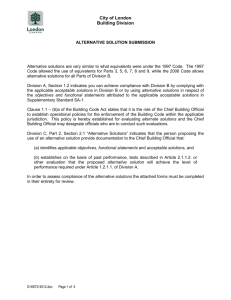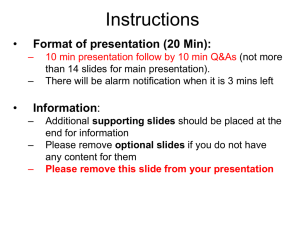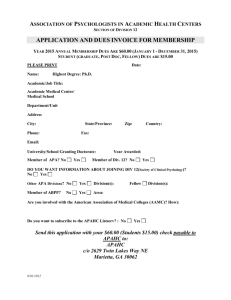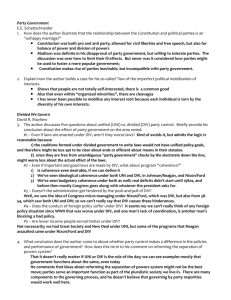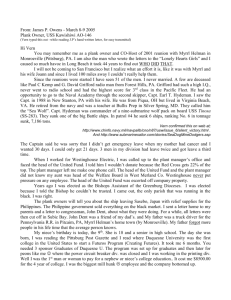c 0 12010
advertisement
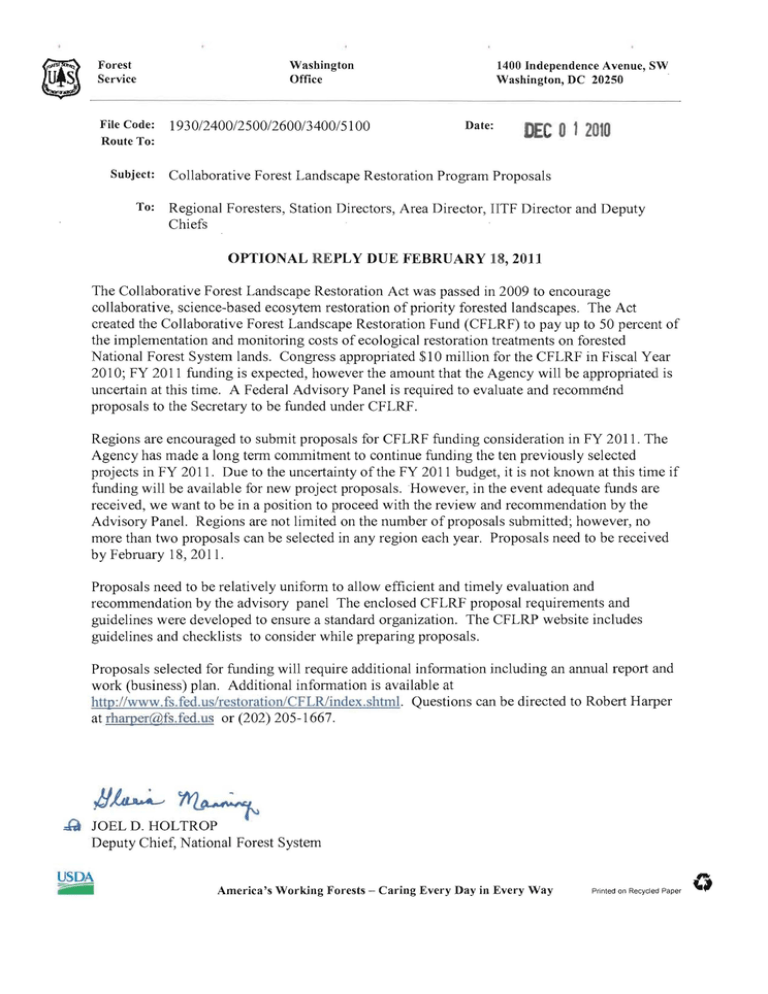
Forest Service File Code: Route To: Subject: Washington Office 1930/2400/2500/2600/3400/5100 1400 Independence Avenue, SW Washington, DC 20250 Date: c 0 12010 Collaborative Forest Landscape Restoration Program Proposals To: Regional Foresters, Station Directors, Area Director, IITF Director and Deputy Chiefs OPTIONAL REPLY DUE FEBRUARY 18, 2011 The Collaborative Forest Landscape Restoration Act was passed in 2009 to encourage collaborative, science-based ecosytem restoration of priOlity forested landscapes. The Act created the Collaborative Forest Landscape Restoration Fund (CFLRF) to pay up to 50 percent of the implementation and monitoring costs of ecological restoration treatments on forested National Forest System lands. Congress appropriated $10 million for the CFLRF in Fiscal Year 2010; FY 2011 funding is expected, however the amount that the Agency will be appropriated is uncertain at this time. A Federal Advisory Panel is required to evaluate and recommend proposals to the Secretary to be funded under CFLRF. Regions are encouraged to submit proposals for CFLRF funding consideration in FY 2011. The Agency has made a long term commitment to continue funding the ten previously selected projects in FY 2011. Due to the uncertainty of the FY 2011 budget, it is not known at this time if funding will be available for new project proposals. However, in the event adequate funds are received, we want to be in a position to proceed with the review and recommendation by the Advisory Panel. Regions are not limited on the number of proposals submitted; however, no more than two proposals can be selected in any region each year. Proposals need to be recei ved by February 18, 2011. Proposals need to be relatively uniform to allow efficient and timely evaluation and recommendation by the advisory panel The enclosed CFLRF proposal requirements and guidelines were developed to ensure a standard organization. The CFLRP website includes guidelines and checklists to consider while preparing proposals. Proposals selected for funding will require additional information including an annual report and work (business) plan. Additional information is available at http://www.fs.fed.us/restorationlCFLRJindex.shtml. Questions can be directed to Robert Harper at rharper@fs.fed.us or (202) 205-1667. :lJ~~ :Q JOEL D. HOLTROP Deputy Chief, National Forest System USDA =- ""­ America's Working Forests - Caring Every Day in Every Way Printed on Recyded Paper . ., cc: CFLRP Contacts Anne Zimmennann Janette Kaiser Rob Mangold Carlos Rodriquez-Franco Tom Peterson Vicki Christensen CFLRP Proposal Requirements A. The Collaborative Forest Landscape Restoration Program (CFLRP) proposals must use the following standardized format: 1. The page limit for proposals is 20 pages, including all outlined sections below, but not including attachments. Please do not include any attachments or appendices other than those outlined in the Table of Contents, and please do not submit letters of support. The proposal may include hyperlinks to other documents, but these documents may not be read and should not be necessary to the integrity of the proposal. 2. Proposals should use 12 point font and have 1” margins. 3. Page numbers must appear in the upper right hand corner of each page. Each page must include the proposal name and page number (e.g. Project XYZ, Page #). Page numbers should be sequential throughout the document, not by section. B. 4. Attach the package with a single clip (no staples) at the upper left hand corner. Bold text identifies required sections. Proposals must include all required sections without extraneous material. All attachments and tables are required. Questions listed below are only intended to help guide the proposal’s narrative for that section. Do not use a question and answer format in the proposal 1 Executive Summary: Please fill out the following template and include it at the beginning of your proposal. The Executive Summary should not exceed one page: Dominant forest type(s): ______________________________________________________________________________ Total acreage of the landscape:_____________________ Total acreage to receive treatment: _____________________ Total number of NEPA ready acres:__________________ Total number of acres in NEPA process:___________________ Description of the most significant restoration needs and actions on the landscape: ____________________________________________________________________________________________________________ ____________________________________________________________________________________________________________ ____________________________________________________________________________________________________________ ____________________________________________________________________________________________________________ Description of the highest priority desired outcomes of the project at the end of the 10 year period: ____________________________________________________________________________________________________________ ____________________________________________________________________________________________________________ ____________________________________________________________________________________________________________ ____________________________________________________________________________________________________________ Description of the most significant utilization opportunities linked to this project __________________________________________________________________________________________________ __________________________________________________________________________________________________ __________________________________________________________________________________________________ __________________________________________________________________________________________________ Name of the National Forest, collaborative groups, and other major partner categories involved in project development: __________________________________________________________________________________________________ __________________________________________________________________________________________________ __________________________________________________________________________________________________ __________________________________________________________________________________________________ Describe the community benefit including number and types of jobs created. __________________________________________________________________________________________________ __________________________________________________________________________________________________ __________________________________________________________________________________________________ __________________________________________________________________________________________________ Total dollar amount requested in FY11_____________ Total dollar amount requested for life of project______________ Total dollar amount provided as Forest Service match in FY11 _______________________________________________ Total dollar amount provided as Forest Service match for life of project________________________________________ Total dollar amount provided in Partnership Match in FY11 __________________________________________________ Total dollar amount provided in Partnership Match for life of project __________________________________________ Total in‐kind amount provided in Partnership Match in FY11_________________________________________________ Total in‐kind amount provided in Partnership Match for life of project_________________________________________ Time frame for the project (from start to finish) ______________________ 2 Table of Contents: The proposal table of contents should include the following sections in the order outlined. o Ecological, Social and Economic Context…………………………………………………………………………………………pxx o Summary of Landscape Strategy………………………………………………………………………………………………..…..pxx o Proposed Treatment ………………………………………………………………………………………………………………………pxx o Collaboration and Multi‐party Monitoring………………………………………………………………………………………pxx o Utilization……………………………………………………………………………………………………………………………………….pxx o Benefits to Local Economies……………………………………………………………………………………………………………pxx o Funding Plan…………………………………………………………………………………………………………………………………..pxx o Attachments Attachment A: Planned Accomplishment Table Attachment B: Reduction of related wildfire management costs o “Results‐ Cost Savings” of R‐CAT spreadsheet available on the CFLRP website1 o Documentation of assumptions and data sources used when populating the R‐CAT spreadsheet Attachment C: Members of the Collaborative Table Attachment D: Letter of Commitment Attachment E: Predicted Jobs Table from TREAT spreadsheet Attachment F: Funding Estimates Attachment G: Maps Ecological, Social and Economic Context: This section should describe the current ecological, wildfire risk, social and economic conditions of this landscape. This should include a brief history of what created the unsustainable current conditions, desired conditions, and current ecological and economic factors affecting the ability to address these concerns. Please consider the following questions as applicable: o What are the ownership patterns? Articulate how public, private, state, tribal, county and other lands are relevant in the proposed landscape and how this fits with the Chief’s “all lands” approach. o Describe the types and conditions of current vegetation. How does this compare to desired vegetation types and conditions? Please provide adequate baseline information about the ecological conditions of the planning area so that changes can be identified through monitoring. o Describe the current wildfire conditions (fire regime, including fuel type, return interval, severity and scale; and condition class), and the desired wildfire conditions. o What other threats to forest ecosystem sustainability (i.e. water quality, watershed functions, wildlife viability, invasive species) exist under current conditions? 1 R-CAT grew from the Appendix B Spreadsheet, which was originally a part of the Suggested Economic Analysis Procedures and Templates was developed by the Rocky Mountain Research Station and the Western Wildlands Environmental Threat Assessment Center, along with economists from the National Forest System in response to the Omnibus Public Land Management Act of 2009. Available at HTTP://WWW.FS.FED.US/RESTORATION/CFLR/SUBMITTINGPROPOSALS.SHTML 3 o What are the current local economic conditions and how will this landscape scale project affect the local economy? Summary of Landscape Strategy: Proposals for CFLRP funding are required to be based on a complete or substantially complete landscape restoration strategy. This section should provide a summary of the detailed landscape strategy on which the proposal is based. A hyperlink to the full strategy should also be provided (understanding that not all Panel members will read the full strategy and hard copies will not be provided to the Panel members). For guidance on elements of a Landscape Strategy, please visit the CFLRP website. http://www.fs.fed.us/restoration/CFLR/submittingproposals.shtml. Please include the following elements in the Summary: o Please include a brief summary of the landscape strategy, along with a hyperlink to the more in depth strategy. o Describe why this landscape is socially, ecologically and economically significant. Why are the acres proposed for treatment a priority in this landscape? Proposed Treatment: This section should describe what the treatments will be and why those treatments will result in ecological outcomes sought by the project proponents. Please consider the following questions as applicable: o How was the area of total “landscape” chosen and defined? How many acres in the landscape are forested national forest system lands? o What are the ecological restoration goals and treatment objectives? o What ecological restoration has occurred and how many acres of each vegetation type are already in a desired condition? o What types (harvest, mastication, fire, in‐stream structures, ripping roads, etc.) of treatments are proposed? How many acres will be treated and when? This should be described in a narrative, and the Planned Accomplishment Table in Attachment A should be filled out. o Will the treatments be strategically implemented in the landscape, consistent with restoration goals? If yes, please describe how this implementation will be prioritized and how it will maximize treatment effectiveness of the restoration strategy. Consider how treatments on other lands will complement those on NFS lands. o Describe the desired conditions and establish a clear strategy for achieving conditions within the planned time frame for the following planning areas: fish, wildlife, or T&E species water quality and watershed function invasive and exotic species insect and disease concerns roads and trails o How will old growth stands and large trees be appropriately maintained to achieve restoration strategy objectives? o How do the best available science and science tools justify the choice of restoration goals and methods? o What NEPA decisions have been made and what decisions remain? o Please answer the following questions regarding fire : What wildfire behavior is anticipated in restored conditions? How will the risk of uncharacteristic wildfire be reduced? How will natural fire regimes be reestablished and maintained? How will wildfires and prescribed fire be managed in a restored landscape? What kinds of prescribed burning will occur (e.g., broadcast, pile burning) and on what schedule? 4 Are there wildland/urban interface lands within the landscape? If so, are these areas covered by existing Community Wildfire Protection Plans? In order to calculate cost reductions in management of uncharacteristic wildfire, please utilize the R‐ CAT spreadsheet, available on the CFLRP website2 . In Attachment B to the proposal, please include a copy of the completed “Results‐ Cost Savings” table of the R‐CAT spreadsheet, as well as documentation of data sources and assumptions utilized to populate the table. Summarize the cost reductions in management of uncharacteristic wildfire that will likely occur as a result of the implementation of this restoration strategy. Please link this response to the Expected Wildfire Cost Saving and Discounted Net Change in Wildfire Management Program Costs calculated in Attachment B. Collaboration and Multi‐party Monitoring: This section should describe the collaborative group associated with the proposal, including membership, governance and decision‐making processes, and how the group was involved in proposal development. This section should also describe whether a multiparty monitoring (MPM) process is in place or being developed, and if the MPM will address ecological, economic and community benefits of the project. Please consider the following questions as applicable: o Who is represented in the collaborative? Please fill out the Members of the Collaborative table, and include it in your proposal as Attachment C. Please be sure to include contact information for a Forest Service representative that is a member of the collaborative as well. o What is the collaborative’s decision making process (consensus, majority rule, etc)? o How long has the collaborative group been working together? How often does the collaborative meet? o What has the collaborative group accomplished that would help focus the landscape restoration goal and achieve the objectives? o Please explain the importance of the collaborative process in the successful implementation of the proposal and monitoring strategy. o As Attachment D, please include a single letter of commitment developed and signed by all members of the collaborative. o Were any potential collaborators in the landscape or vicinity absent? What was done to seek their participation in the collaboration? o Has the group developed a multi‐party monitoring (MPM) framework? If not, describe plans to develop this framework. o Does/will the MPM program have ecological, social, and economic dimensions? o What type of monitoring will be employed (e.g., implementation, effectiveness)? o Describe the process for development of effectiveness monitoring objectives and implementation of ecological, social and economic monitoring. o If already known, what are the specific methods that will be used to track the indicators, both ecological and socio‐economic? o If already known, how will success be measured? o How will monitoring results be used to modify the restoration plan if results suggest the need to modify and adapt? Utilization: This section should describe what the utilization strategy is and how it will support the landscape strategy and community benefit objectives of the project. Please consider the following questions as applicable: o Describe the utilization strategy for biomass and small diameter trees removed by restoration treatments: 2 R-CAT grew from the Appendix B Spreadsheet, which was originally a part of the Suggested Economic Analysis Procedures and Templates that was developed by the Rock y Mountain Research Station and the Western Wildlands Environmental Threat Assessment Center, along with economists from the National Forest System in response to the Omnibus Public Land Management Act of 2009. Available at HTTP://WWW.FS.FED.US/RESTORATION/CFLR/SUBMITTINGPROPOSALS.SHTML 5 o o Benefits to local economies: This section should describe what this project will mean to the community. Please consider the following questions as applicable: o o o o o o o o o Clearly convey how the landscape restoration strategy and restoration goals will drive the amount of material removed and how the scale and diversity of utilization strategies will ensure that treatments are ecologically driven. What is the estimated volume of the material to be utilized? What type and size of material will be removed? Describe the type of product(s) that will be created in the utilization strategy, and the likely use. What value would the removed material have and how would it help to offset treatment costs? What associated industry exists in the area? Is there existing manufacturing capacity? Is there local capacity or markets for utilization of the materials? Be clear about whether the proposed utilization strategy is based on proposed or existing facilities. To the extent that there is uncertainty in the utilization strategy, discuss how the group will approach that uncertainty and if there is a process to adapt the utilization strategy over the 10‐year period? Describe how this project, if funded, will positively affect the local communities. Will the strategy retain or create local capacity to perform restoration work? To process/manufacture material? Will jobs be created by the additional CFLRP funding? If so, what kind, how many, and for how long? Please populate the table in Attachment E using the TREAT spreadsheet. Please use only proposed CFLR funds as your input. The spreadsheet tool and instructions are available under the Annual Report and Work Plan section of the CFLR website at http://www.fs.fed.us/restoration/CFLR/annual.shtml. Please estimate what proportion of the jobs projected using the TREAT spreadsheet will be part time, full time, seasonal and year round. Will employment or training opportunities be provided for local private, nonprofit, and/or cooperative entities? For Youth Groups? For existing or proposed small businesses? Are there training programs or support services available through this project to assist local contractors in effectively competing for work and/or rebuilding capacity in locations where capacity has been lost? Is there an existing local contractor pool that could compete for work offered through this project? Does the group intend to use best value criteria ensure that local economic benefit is a significant criterion in contract award? What mechanisms (timber/service/stewardship contracts, agreements, force account) will be used to accomplish the restoration work? How will they be used to create local economic benefit or link to local infrastructure? Funding Plan: Please consider the following questions as applicable: o o o o o Why is the estimated Multi‐party Monitoring budget appropriate for the scale of the project? Describe the federal and non‐federal investments that are anticipated within the landscape. What non‐federal investments are anticipated outside of the proposed landscape that may affect the successful restoration of the landscape? USDI Funding ‐ If actions under the jurisdiction of the Secretary of Interior are proposed, the appropriate State Director of the BLM, Regional Director of BIA, or other USDI official shall include a plan to fund their proposed actions Other Funding ‐ If other actions are proposed, the Regional Forester shall provide evidence the landowner intends to participate and provide appropriate funding. 6 Attachment A Projected Accomplishments Table Performance Measure Acres treated annually to sustain or restore watershed function and resilience Acres of forest vegetation established Acres of forest vegetation improved Manage noxious weeds and invasive plants Highest priority acres treated for invasive terrestrial and aquatic species on NFS lands Acres of water or soil resources protected, maintained or improved to achieve desired watershed conditions. Acres of lake habitat restored or enhanced Miles of stream habitat restored or enhanced Acres of terrestrial habitat restored or enhanced Number of units to be treated over 10 years using CFLR funds Code Number of units to be treated over 10 years using other FS funds Number of CFLR funds units to be to be used treated over over 10 years 10 years using Partner Funds3 Other FS funds to be used over 10 years4 Partner funds to be used over 10 years WTRSHD‐ RSTR‐ ANN FOR‐ VEG‐EST FOR‐ VEG‐IMP INVPLT‐ NXWD‐ FED‐AC INVSPE‐ TERR‐ FED‐AC S&W‐ RSRC‐ IMP HBT‐ ENH‐LAK HBT‐ ENH‐ STRM HBT‐ ENH‐ TERR 3 These values should reflect only units treated on National Forest System Land Matching Contributions: The CFLR Fund may be used to pay for up to 50 percent of the cost of carrying out and monitoring ecological restoration treatments on National Forest System (NFS) lands. The following BLI’s have been identified as appropriate for use as matching funds to meet the required minimum 50% match of non-CFLR funds: ARRA, BDBD, CMEX, CMII, CMLG, CMRD, CMTL, CWFS, CWKV, CWK2, NFEX, NFLM (Boundary), NFMG (ECAP/AML), NFN3, NFTM, NFVW, NFWF, PEPE, RBRB, RTRT, SFSF, SPFH, SPEX, SPS4, SSCC, SRS2, VCNP, VCVC, WFEX, WFW3, WFHF. The following BLI’s have been identified as NOT appropriate for use as matching funds to meet the required minimum 50% match of non-CFLR funds: ACAC, CWF2, EXEX, EXSL, EXSC, FDFD, FDRF, FRRE, LALW, LBLB, LBTV, LGCY, NFIM, NFLE, NFLM (non-boundary), NFMG (non-ECAP), NFPN, NFRG, NFRW, POOL, QMQM, RIRI, SMSM, SPCF, SPCH, SPIA, SPIF, SPS2, SPS3, SPS5, SPST, SPUF, SPVF, TPBP, TPTP, URUR, WFPR, WFSU. 4 7 Performance Measure Acres of rangeland vegetation improved Miles of high clearance system roads receiving maintenance Miles of passenger car system roads receiving maintenance Miles of road decommissioned Miles of passenger car system roads improved Miles of high clearance system road improved Number of stream crossings constructed or reconstructed to provide for aquatic organism passage Miles of system trail maintained to standard Miles of system trail improved to standard Miles of property line marked/maintained to standard Acres of forestlands treated using timber sales Volume of timber sold (CCF) Green tons from small diameter and low value trees removed from NFS lands and made available for bio‐ energy production Number of units to be treated over 10 years using CFLR funds Code RG‐VEG‐ IMP Number of units to be treated over 10 years using other FS funds Number of CFLR funds units to be to be used treated over over 10 years 10 years using Partner Funds3 Other FS funds to be used over 10 years4 Partner funds to be used over 10 years RD‐HC‐ MAIN RD‐PC‐ MAINT RD‐ DECOM RD‐PC‐ IMP RD‐HC‐ IMP STRM‐ CROS‐ MTG‐STD TL‐ MAINT‐ STD TL‐IMP‐ STD LND‐BL‐ MRK‐ MAINT TMBR‐ SALES‐ TRT‐AC TMBR‐ VOL‐SLD BIO‐NRG 8 Performance Measure Acres of hazardous fuels treated outside the wildland/urban interface (WUI) to reduce the risk of catastrophic wildland fire Acres of hazardous fuels treated inside the wildland/urban interface (WUI) to reduce the risk of catastrophic wildland fire Acres of wildland/urban interface (WUI) high priority hazardous fuels treated to reduce the risk of catastrophic wildland fire Number of priority acres treated annually for invasive species on Federal lands Number of priority acres treated annually for native pests on Federal lands Number of units to be treated over 10 years using CFLR funds Code Number of units to be treated over 10 years using other FS funds Number of CFLR funds units to be to be used treated over over 10 years 10 years using Partner Funds3 Other FS funds to be used over 10 years4 Partner funds to be used over 10 years FP‐ FUELS‐ NON‐ WUI FP‐ FUELS‐ NON‐ WUI FP‐ FUELS‐ WUI SP‐ INVSPE‐ FED‐AC SP‐ NATIVE – FED‐AC Attachment B o o Insert “Results‐ Cost Savings” of the R‐CAT spreadsheet, available on the CFLRP website5 . Document data sources and assumptions utilized to populate the table. Attachment C o Please be sure to include contact information for a Forest Service representative that is on the collaborative as well. 5 R-CAT grew from the Appendix B Spreadsheet, which was originally a part of the Suggested Economic Analysis Procedures and Templates that was developed by the Rock y Mountain Research Station and the Western Wildlands Environmental Threat Assessment Center, along with economists from the National Forest System in response to the Omnibus Public Land Management Act of 2009. Available HTTP://WWW.FS.FED.US/RESTORATION/CFLR/SUBMITTINGPROPOSALS.SHTML 9 Members of the Collaborative: Organization Name Contact Name Phone Number Role in Collaborative6 Attachment D o Please include a letter of commitment developed and signed by all members of the collaborative 6 Responses to this category should reflect the role the entity plays in the collaborative process, the interests they represent and/or any other function they serve in the collaborative. Responses could include descriptions such as “proposal author”, “Will participate in monitoring”, etc. If the collaborative member participated specifically in the development of this proposal, please be clear about what their participation in developing the proposal was. 10 Attachment E o Please populate this table using the TREAT spreadsheet. Please feed the table using only proposed CFLR funds as your input. The spreadsheet and instructions are available under the Annual Report and Work Plan section of the CFLR website Predicted Jobs Table from Treat Spreadsheet: Employment (# Part and Full‐time Jobs) Labor Inc (2009 $) Direct Indirect and Induced Total Direct Indirect and Induced Sawmills #DIV/0! #DIV/0! #DIV/0! #DIV/0! #DIV/0! #DIV/0! Plywood and Veneer Softwood #DIV/0! #DIV/0! #DIV/0! #DIV/0! #DIV/0! #DIV/0! Plywood and Veneer Hardwood #DIV/0! #DIV/0! #DIV/0! #DIV/0! #DIV/0! #DIV/0! Oriented Strand Board (OSB) #DIV/0! #DIV/0! #DIV/0! #DIV/0! #DIV/0! #DIV/0! Mills Processing Roundwood Pulp Wood #DIV/0! #DIV/0! #DIV/0! #DIV/0! #DIV/0! #DIV/0! Other Timber Products #DIV/0! #DIV/0! #DIV/0! #DIV/0! #DIV/0! #DIV/0! Commercial Forest Products Total Facilities Processing Residue From Sawmills #DIV/0! #DIV/0! #DIV/0! #DIV/0! #DIV/0! #DIV/0! Facilities Processing Residue From Plywood/Veneer #DIV/0! #DIV/0! #DIV/0! #DIV/0! #DIV/0! #DIV/0! Biomass‐‐Cogen #DIV/0! #DIV/0! #DIV/0! #DIV/0! #DIV/0! #DIV/0! Total Commercial Forest Products #DIV/0! #DIV/0! #DIV/0! #DIV/0! #DIV/0! #DIV/0! Facilities, Watershed, Roads and Trails #DIV/0! #DIV/0! #DIV/0! #DIV/0! #DIV/0! #DIV/0! Other Project Activities Abandoned Mine Lands #DIV/0! #DIV/0! #DIV/0! #DIV/0! #DIV/0! #DIV/0! Ecosystem Restoration, Hazardous Fuels, and Forest Health #DIV/0! #DIV/0! #DIV/0! #DIV/0! #DIV/0! #DIV/0! Thinning and Biomass #DIV/0! #DIV/0! #DIV/0! #DIV/0! #DIV/0! #DIV/0! Commercial Firewood 0.0 0.0 $0 Contracted Monitoring #DIV/0! #DIV/0! 0.0 #DIV/0! #DIV/0! #DIV/0! $0 #DIV/0! $0 FS Implementation and Monitoring Total Other Project Activities #DIV/0! #DIV/0! #DIV/0! #DIV/0! #DIV/0! #DIV/0! #DIV/0! #DIV/0! #DIV/0! #DIV/0! #DIV/0! #DIV/0! Total All Impacts #DIV/0! #DIV/0! #DIV/0! #DIV/0! #DIV/0! #DIV/0! 11 Attachment F o Funding Estimate Provide funding expectations and CFLRP funding request for the 10 year life span of the project using format below. A new table should be filled out for each year of the project:7 (Copy table and provide the planned funding for each additional fiscal year). Funds to be used on NFS lands for ecological restoration treatments and monitoring that would be available in FY 20xx to match funding from the Collaborative Forested Landscape Restoration Fund Fiscal Year 20xx Funding Type Dollars/Value Planned 1. FY 20xx Funding for Implementation 2. FY 20xx Funding for Monitoring 3. USFS Appropriated Funds 4. USFS Permanent & Trust Funds 5. Partnership Funds 6. Partnership In‐Kind Services Value 7. Estimated Forest Product Value 8. Other (specify) 9. FY 20xx Total (total of 1‐6 above for matching CFLRP request) 10. FY 20xx CFLRP request (must be equal to or less than above total) Funding off NFS lands associated with proposal in FY 2010 (does not count toward funding match from the Collaborative Forested Landscape Restoration Fund) Fiscal Year 20xx Funding Type Dollars Planned 11. USDI BLM Funds 12. USDI (other) Funds 13. Other Public Funding Private Funding 7 Instructions for filling out Funding Estimate Table. Should be one table for each of the ten fiscal years of the project. Line 1: Enter total non-CFLR funds that will be used for implementation Line 2: Enter total non-CFRL funds that will be used for monitoring; Line 3: Enter the appropriated funds that will be used to match the CFLR funds. Appropriate BLI’s include: ARRA, BDBD, CMEX, CMII, CMLG, CMRD, CMTL, CWFS, CWKV, CWK2, NFEX, NFLM (Boundary), NFMG (ECAP/AML), NFN3, NFTM, NFVW, NFWF, PEPE, RBRB, RTRT, SFSF, SPFH, SPEX, SPS4, SSCC, SRS2, VCNP, VCVC, WFEX, WFW3, WFHF. The following BLI’s have been identified as NOT appropriate for use as matching funds to meet the required minimum 50% match of non‐CFLR funds: ACAC, CWF2, EXEX, EXSL, EXSC, FDFD, FDRF, FRRE, LALW, LBLB, LBTV, LGCY, NFIM, NFLE, NFLM (non‐boundary), NFMG (non‐ECAP), NFPN, NFRG, NFRW, POOL, QMQM, RIRI, SMSM, SPCF, SPCH, SPIA, SPIF, SPS2, SPS3, SPS5, SPST, SPUF, SPVF, TPBP, TPTP, URUR, WFPR, WFSU. Line 4: Enter any USFS Permanent & Trust Funds that will be used to match CFLR funds. Lines 5, 6: Enter any partnership funds or Partner ship in‐kind services that will be used to match CFLR funds Line 7: Include any estimated Forest Product Value Line 8: Enter any additional funds to be used for CFLR matching not captured above Line 9: line 9 = line 3 + line 4 + line 5 + line 6 + line 7 + line 8 = line 1 + line 2 Line 10: Enter the amount you are requesting in CFLR funds. This should be equal to or less than the value in Line 9 Line 11, 12, 13: Enter any USDI BLM funds, other USDI funds, or other Public, non USFS funding. 12 Attachment G o Maps: All proposals should include an 8.5 x 11” map or maps showing the location and context of the project, priorities identified by the collaborative, as well as the planned treatments that are known at the time of the proposal. Maps may be submitted in black and white or color, but will only be reproduced in black and white. Color versions of maps will be available to Advisory Panel members in digital format only. 13




